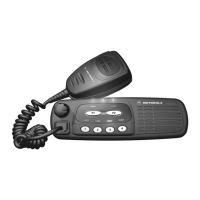Chapter 2: 2-4 Control Head (CDM1250 / PRO5100 / CDM1550 Series / PRO7100)
6881091C63-A
speaker connector P0801. The control head speaker can be disconnected only if an external
speaker (connected through the accessory connector) is used.
2.9 Electrostatic Transient Protection
Electrostatic transient protection is provided for the sensitive components in the control head by
diodes VR0811, VR00812, and VR0816 - VR0817. The diodes limit any transient voltages. The
associated capacitors provide radio frequency interference (RFI) protection.
3.0 Control Head (CDM1250 / PRO5100 / CDM1550 Series / PRO7100)
3.1 Power Supplies
The power supply to the control head is taken from the host radio’s FLT A+ voltage via connector
J0801 pin 3 and the regulated 5V via connector J0801 pin 7. The voltage FLT A+ is at battery level
and is used for the LEDs, the back light and to power up the radio using the On/Off/Volume knob.
The stabilized 5V is used for the µP, the display, the display driver and the keypad buttons. The
voltage USW 5V derived from the FLT A+ voltage and stabilized by the series combination of R0822,
VR0822 is used to buffer the internal RAM of the µP (U0831). C0822 allows the battery voltage to be
disconnected for a couple of seconds without losing RAM parameters. Dual diode D0822 prevents
radio circuitry from discharging this capacitor. When the supply voltage is applied to the radio, C0822
is charged via R0822 and D0822. To avoid the µP entering the wrong mode when the radio is
switched on while the voltage across C0822 is still too low, the regulated 5V supply charges C0822
via diode D0822.
3.2 Power On/Off
The On/Off/Volume knob, when pressed, switches the radio’s voltage regulators on by connecting
line ON OFF CONTROL to line UNSW 5V via D0821. Additionally, 5V at the base of digital transistor
Q0822 signals the control head’s µP about the pressed knob. The µP asserts pin 62 and line CH
REQUEST low to hold line ON OFF CONTROL at 5V via Q0823 and D0821. The high line ON OFF
CONTROL also informs the host radio that the control head’s µP wants to send data via SBEP bus.
When the radio returns a data request message, the µP will inform the radio about the pressed knob.
If the radio was switched off, the radio’s µP will switch it on and vice versa. If the On/Off/Volume knob
is pressed while the radio is on, the software detects a low state on line ON OFF SENSE, the radio is
alerted via line ON OFF CONTROL, and sends a data request message. The control head µP will
inform the radio about the pressed knob and the radio’s µP will switch the radio off.
3.3 Microprocessor Circuit
The control head uses the Motorola 68HC11E9 µP (U0831) to control the LEDs and the LCD and to
communicate with the host radio. RAM and ROM are contained within the µP itself.
The µP generates its clock using the oscillator inside the µP along with a 8 MHz ceramic resonator
(U0833) and R0920.
The µP’s RAM is always powered to maintain parameters such as the last operating mode. This is
achieved by maintaining 5V at µP pin 25. Under normal conditions, when the radio is off, USW 5V is
formed by FLT A+ running to D0822. C0822 allows the battery voltage to be disconnected for a
couple of seconds without losing RAM parameters. Diode D0822 prevents radio circuitry from
discharging this capacitor.
There are eight analog-to-digital converter ports (A/D) on the µP. They are labeled within the device
block as PE0-PE7. These lines sense the voltage level ranging from 0 to 5V of the input line and

